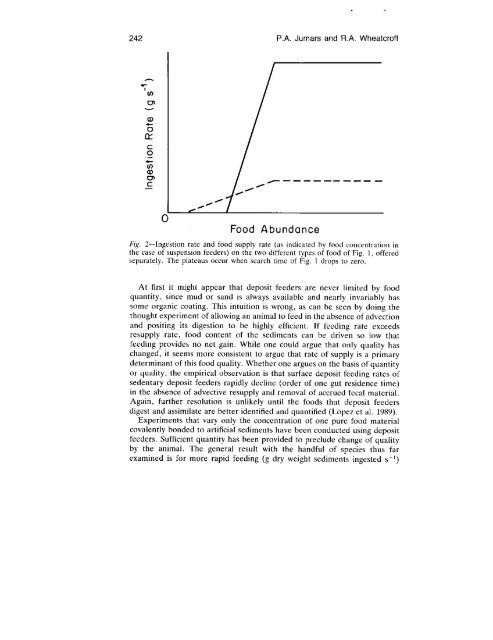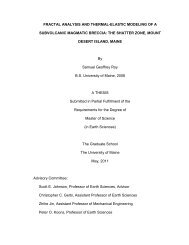Responses of Benthos to Changing Food Quality and Quantity, with ...
Responses of Benthos to Changing Food Quality and Quantity, with ...
Responses of Benthos to Changing Food Quality and Quantity, with ...
Create successful ePaper yourself
Turn your PDF publications into a flip-book with our unique Google optimized e-Paper software.
242 P .A . Jumars <strong>and</strong> R .A . Wheatcr<strong>of</strong>t<br />
0<br />
<strong>Food</strong><br />
Abundance<br />
Fig. 2-Ingestion rate <strong>and</strong> food supply rate (as indicated by food concentration in<br />
the case <strong>of</strong> suspension feeders) on the two different types <strong>of</strong> food <strong>of</strong> Fig . 1, <strong>of</strong>fered<br />
separately . The plateaus occur when search time <strong>of</strong> Fig . I drops <strong>to</strong> zero .<br />
At first it might appear that deposit feeders are never limited by food<br />
quantity, since mud or s<strong>and</strong> is always available <strong>and</strong> nearly invariably has<br />
some organic coating . This intuition is wrong, as can be seen by doing the<br />
thought experiment <strong>of</strong> allowing an animal <strong>to</strong> feed in the absence <strong>of</strong> advection<br />
<strong>and</strong> positing its digestion <strong>to</strong> be highly efficient . If feeding rate exceeds<br />
resupply rate, food content <strong>of</strong> the sediments can be driven so low that<br />
feeding provides no net gain . While one could argue that only quality has<br />
changed, it seems more consistent <strong>to</strong> argue that rate <strong>of</strong> supply is a primary<br />
determinant <strong>of</strong> this food quality . Whether one argues on the basis <strong>of</strong> quantity<br />
or quality, the empirical observation is that surface deposit feeding rates <strong>of</strong><br />
sedentary deposit feeders rapidly decline (order <strong>of</strong> one gut residence time)<br />
in the absence <strong>of</strong> advective resupply <strong>and</strong> removal <strong>of</strong> accrued fecal material .<br />
Again, further resolution is unlikely until the foods that deposit feeders<br />
digest <strong>and</strong> assimilate are better identified <strong>and</strong> quantified (Lopez et al . 1989) .<br />
Experiments that vary only the concentration <strong>of</strong> one pure food material<br />
covalently bonded <strong>to</strong> artificial sediments have been conducted using deposit<br />
feeders . Sufficient quantity has been provided <strong>to</strong> preclude change <strong>of</strong> quality<br />
by the animal . The general result <strong>with</strong> the h<strong>and</strong>ful <strong>of</strong> species thus far<br />
examined is for more rapid feeding (g dry weight sediments ingested s - ')
















